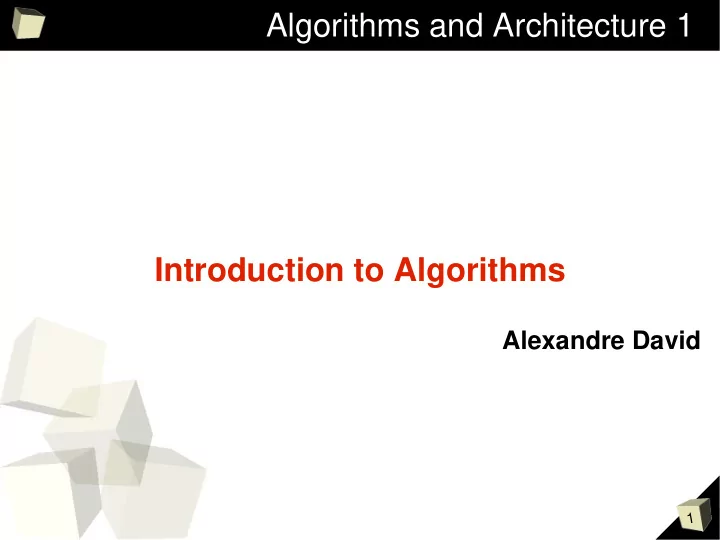

Algorithms and Architecture 1 Introduction to Algorithms Alexandre David 1
Outline ■ Notion of algorithms, GCD example. ■ Algorithmic problem solving. ■ Problem types. ■ Sorting example. ■ Numerical example. ■ Analyzing algorithms. 2
Notion of Algorithms ■ Why study algorithms? ■ What is an algorithm? ■ Example: GCD Known example Nonambiguity requirement Define range of inputs Different representations of the algorithm Several algorithm for the same problem Different ideas, different running speeds 3
GCD: The Problem ■ Greatest common divisor of 2 nonnegative, not both zero integers , denoted gcd(m,n), defined as the largest integer that divides both m and n with a remainder of zero . ■ Algorithms: Consecutive integer checking Euclid's algorithm Prime decomposition 4
Consecutive Integer Checking ■ Idea: solution cannot be greater than min(m,n). Let t=min{m,n}. Check t and try again by decreasing t . ■ Correctness: greatest? Termination? ■ Efficiency: running time? Step 1 : assign min{m,n} to t. Step 2 : divide m by t . If remainder == 0 then step 3, otherwise step 4. Step 3 : divide n by t . If remainder == 0 return t , otherwise step 4. Step 4 : decrease t by 1, go to step 2. 5
Euclid's Algorithms ■ Idea: apply repeadly gcd(m,n) = gcd(n, m mod n) until m mod n is equal to zero (stop when reach gcd(m,0)=m ). Ex: gcd(60,24)=gcd(24,12)=gcd (12,0)=12. Algorithm Euclid(m,n) // Computes gcd(m,n) by Euclid's algorithm // Input: two nonnegative, non both zero integers m and n // Output: GCD of m and n while n != 0 do r := m mod n m := n n := r return m 6
Prime Decomposition ■ Idea: decomposition into primes and pick the common factors. Step 1 : find the prime factors of m. Step 2 : find the prime factors of n. Step 3 : identify all the common factors (if p is a common factor occuring p m and p n times in m and n , respectively, it should be repeated min{p m , p n } times). Step 4 : Compute the product of all the common factors and return it as the result. ■ Problem: Step 1&2 are sub-problems to be solved. 7
Algorithmic Problem Solving ■ Understand the problem ■ Choose exact/approximate problem solving ■ Decide on appropriate data structures ■ Apply an algorithm design technique ■ Specify the algorithm ■ Prove the correctness of the algorithm ■ Analyze the algorithm – time and space efficiency – simplicity – generality ■ Code the algorithm 8
Problem Types ■ Sorting ■ Searching ■ String processing ■ Graph problems ■ Combinatorial problems ■ Geometric problems ■ Numerical problems 9
Sorting Example ■ The sorting problem: Input : A sequence of n numbers <a1,a2,...,an> Output : A permutation (reordering) <a 1 ',a 2 ',...,a n '> of the input sequence such that a 1 ' ≤ a 2 ' ≤ ... ≤ a n '. ■ Algorithms to solve it: insertion sort, merge sort, quicksort. Insertion sort takes c 1 n 2 in time, merge sort takes c 2 n lg( n ). Let's sort 10 6 elements. Good insertion code 2n 2 : 2(10 6 ) 2 /10 9 =2000s Average merge sort 50n lg( n ): 50*10 6 lg( 10 6 ) / 10 7 =100s on another CPU 100x slower. 0 1
Numerical Example ■ Find x s.t. f(x)=0 for a continuous monotonic function. Bisection algorithm: 2 1 4 3 iterate on [x,y] 0 ,[x,y] 1 .. s.t. f(x)<0 and f(y)>0 (or opposite), reduce interval by 2 everytime. Newton-Raphson algorithm: 5 6 f(x) use the derivative x i+1 =x i -f(x i )/f'(x i ) 1 converge much faster. f'(x 1 ) ■ Numerical problems with flat or 2 exponential functions. 3 f(x) 1 1
Analyzing Algorithms ■ Criteria: Correctness Amount of work done Amount of space used Simplicity, clarity Optimality ■ Asymptotic behaviour ■ Different analysis techniques 2 1
Recommend
More recommend